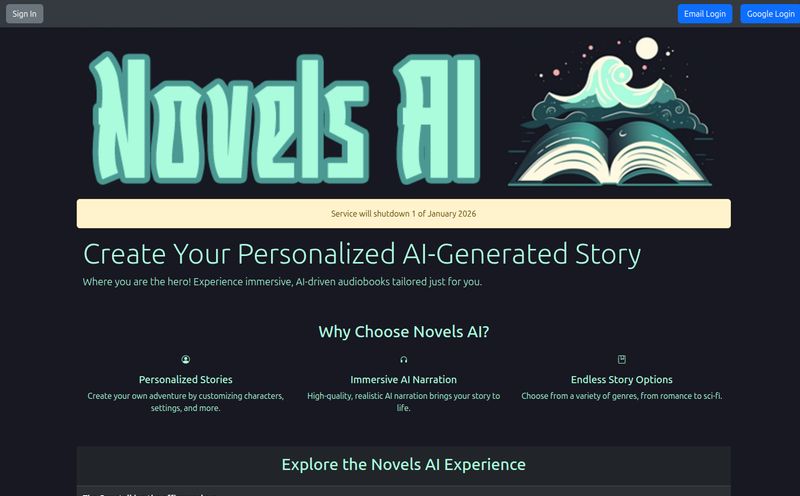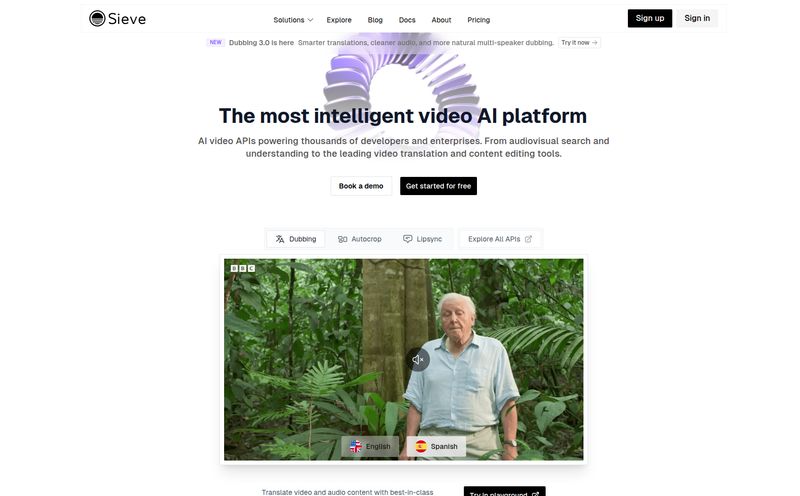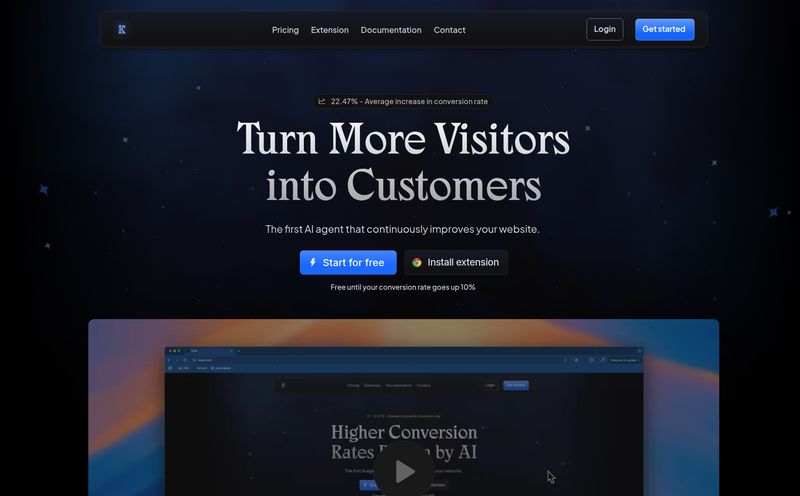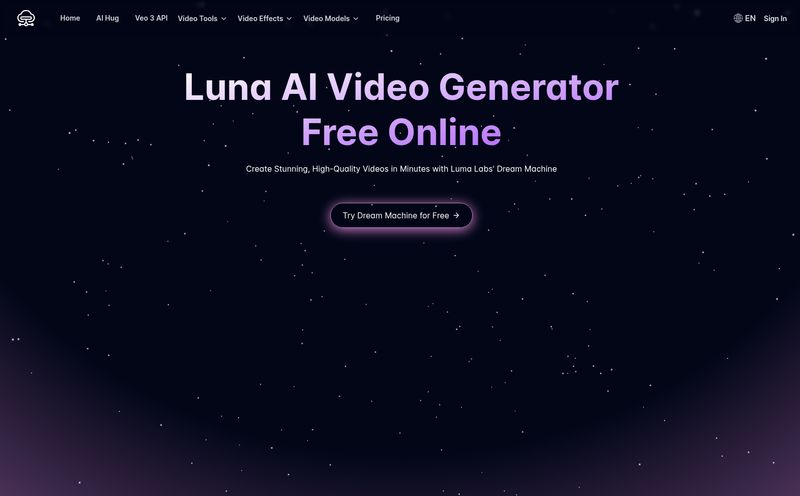I’ve spent more hours than I’d like to admit staring at a blank script, trying to translate the words in my head into actual, moving pictures. The process is a grind. You've got storyboarding, casting (or endlessly scrolling stock footage sites), shooting, editing… it’s a marathon that can drain your budget and your will to live before you even get a first cut. It's the less glamorous side of creation we don't always talk about.
Then, 2024 happened. The AI video world exploded. We all saw the mind-blowing clips from OpenAI's Sora, and tools like Pika and Runway became household names for anyone in the digital creative space. They're amazing, don't get me wrong. But most of them feel like slot machines. You type in a prompt, pull the lever, and hope for the best. Fun for experiments, but for telling a coherent story? A bit of a nightmare.
That's why my ears perked up when I heard about LTX Studio. It wasn't positioning itself as just another text-to-video generator. It called itself a “filmmaking platform.” A full studio. That’s a bold claim. So, of course, I had to see if it was just clever marketing or if this was the AI copilot I’ve been dreaming of. Let's get into it.
So, What Exactly is LTX Studio?
In a nutshell, LTX Studio is an integrated platform designed to take you from a simple idea all the way to a finished video project. It’s made by the team at Lightricks, the folks behind popular apps like Facetune and Videoleap, so they know a thing or two about building user-friendly creative tools. This isn't some fly-by-night startup.
The core difference here is workflow. Instead of just giving you a text box to generate random clips, LTX Studio thinks like a filmmaker. It understands that a story has a beginning, middle, and end. It has scenes. It has consistent characters. It’s a tool built around the process of creation, not just the flashy moment of generation.
A Look at the Core Features (The Director's Toolkit)
Alright, let's pop the hood and see what makes this thing tick. I’m going to walk you through how it feels to actually use it, because a list of features is just… well, a list.
From Blank Page to Full Storyboard
This is where it all starts. You can drop in a full script or just a simple idea, and the AI gets to work. It breaks down your text into distinct scenes and generates a visual storyboard. For me, this was the first “aha!” moment. It’s one thing to write “A detective walks down a rainy, neon-lit alley.” It’s another to see four or five different interpretations of that scene in seconds. It’s pre-visualization on steroids, saving hours of sketching or trying to find the right stock images to build a mood board.
Casting Your Digital Actors
Okay, this is the big one. One of the most frustrating things about current AI video is the lack of consistency. Your hero might have a mustache in one shot and be clean-shaven in the next. LTX Studio tackles this head-on with its AI Character Casting.
You can generate characters and, crucially, keep them consistent across different scenes and shots. You can finally have the same character walk out of a building and get into a car without them mysteriously changing their entire outfit or facial structure. This single feature elevates LTX Studio from a fun toy to a legitimate storytelling tool. This is the holy grail for narrative AI video.
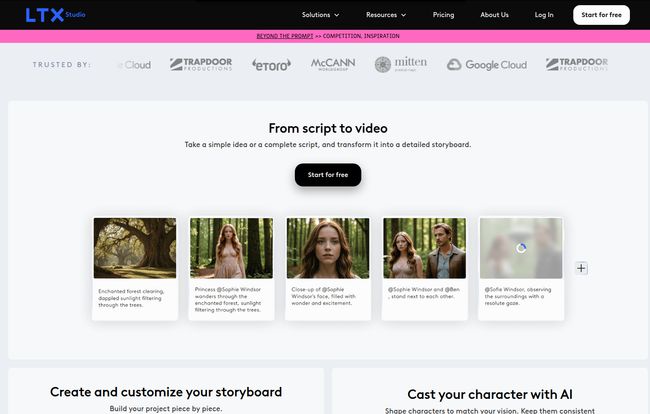
Visit LTX Studio
Getting Granular with Shot Editing
Here’s where LTX Studio really shows its respect for the creator. Once you have your scene and your character, you aren't stuck with the initial generation. The Shot Editing tools let you take control. You can specify camera angles (close-up, wide shot, Dutch angle), camera motion (pan, tilt, zoom), and fine-tune the composition. You have a say in the final product. It’s not quite the same as having a full suite like Adobe Premiere, but for an AI platform, this level of directorial control is a massive step forward.
The Final Polish: Pitch Decks and More
Let's say you've storyboarded your masterpiece. Now you need to get buy-in from a client or a producer. LTX has a built-in Pitch Deck Generator. It automatically pulls your scenes, characters, and project aesthetic into a slick presentation. As a freelancer who has spent countless hours cobbling together pitch decks in Canva, this feature made me weep a single, beautiful tear of joy. Its a huge time-saver.
My Honest Thoughts: The Good, The Bad, and The 'Coming Soon'
No tool is perfect, especially in a field moving this fast. So, let’s get real about LTX Studio.
The good stuff is obvious. The holistic, workflow-first approach is brilliant. The character consistency is a game-changer. And the amount of creative control is what professionals have been asking for. It’s a tool that wants to collaborate with you, not replace you.
But there are some rough edges. The collaboration tools, for instance, are a bit limited unless you're on a paid plan. And some key features, like in-line commenting and suggestions for team feedback, are still labeled “coming soon.” It’s like buying a brand-new car and being told the killer sound system will be activated in a future software update. You’re excited for it, but you want to blast your tunes now.
Also, for the super-technical crowd, you can’t integrate your own custom-trained AI models. You're working within the LTX ecosystem. For 99% of users, this is a non-issue, but for agencies with proprietary models, it's a limitation worth noting.
What's This Going to Cost Me? LTX Studio Pricing Breakdown
Money talks. The pricing model is based on “computing seconds,” which is basically a credit system for how much processing power you use. It's a pretty standard model in the AI space.
| Plan | Price | Computing Seconds | Best For |
|---|---|---|---|
| Free | $0 | 800 (one-time) | Kicking the tires and seeing if you like it. |
| Lite | $12 / month | 8,640 / month | Hobbyists and solo creators with light project needs. |
| Standard | $28 / month | 28,800 / month | The sweet spot for most freelancers, marketers, and serious creators. |
| Pro | $100 / month | 90,000 / month | Power users, small agencies, and those with high-volume needs. |
The free plan is generous enough to let you get a real feel for the platform, which I always appreciate. You can find more details on their official pricing page.
Who is LTX Studio Really For?
After playing around with it, I see a few groups who would absolutely love this.
- Indie Filmmakers & Screenwriters: This is an incredible tool for pre-visualization and creating concept trailers. You can bring your script to life to pitch for funding without spending a dime on production.
- Marketers & Ad Agencies: Need to quickly mock up a video ad campaign? Want to test three different visual concepts for a social media video? This is your tool. The speed from idea to presentable concept is insane.
- Solo Creators & YouTubers: LTX Studio can effectively act as your one-person production house. You can create animated explainers, narrative shorts, and visual B-roll that would have previously required a team or complex animation skills.
The Final Verdict: Is LTX Studio Worth Your Time (and Money)?
Yes. A thousand times, yes. LTX Studio isn’t just another AI gimmick. It’s one of the first platforms that feels like it was designed by people who actually understand the process of making things. It bridges the gap between the chaotic creativity of AI and the structured workflow needed to tell a good story.
Is it going to put Hollywood directors out of a job? Of course not. But is it going to empower a new generation of creators, marketers, and filmmakers to tell stories that were previously locked away by budget and technical barriers? Absolutely. My advice is simple: go sign up for the free plan. The 800 computing seconds are more than enough to see if the magic works for you. The future of creative collaboration is here, and it looks a lot like a studio, not a slot machine.
LTX Studio FAQ
- Can I use my own face or characters in LTX Studio?
- You can generate and customize characters with incredible detail within the platform. However, as of now, you can't upload a photo of a specific person (like yourself) to create a character, though this kind of tech is evolving fast!
- How do the 'computing seconds' actually work?
- Think of them like a digital currency or credits. Every time you generate an image, a video clip, or perform a complex task, it uses a certain number of seconds from your monthly allowance. Generating a 4-second video clip might use more seconds than generating a single storyboard image.
- Is the video quality good enough for professional use?
- It's getting very, very good. It's definitely professional quality for social media, digital marketing, internal corporate videos, and pitching concepts. You probably wouldn't screen it in a 4K cinema just yet, but for the vast majority of online video content, the quality is more than sufficient.
- How does LTX Studio compare to tools like OpenAI's Sora or Pika?
- The biggest difference is the workflow. Sora and Pika are primarily powerful generators—you give them a prompt, they give you a clip. LTX Studio is a full production studio that includes a generator but also adds storyboarding, locked character consistency, shot-by-shot editing, and pitch deck creation. It's about managing an entire project, not just a single clip.
- Can I export my project to use in other editing software like Premiere or Final Cut?
- Yes, you can export the individual video shots you generate, as well as the complete pitch deck. This allows you to do your initial creation and visualization in LTX Studio and then move to a traditional Non-Linear Editor (NLE) for final assembly, sound design, and color grading if you need that extra layer of pro polish.
Conclusion
The conversation around AI in the creative fields is often filled with fear and hype. What I like about LTX Studio is that it feels practical and empowering. It's a tool built for artists, not to replace them. It understands that our best work comes from a blend of imagination and control. While its not perfect, it represents one of the most complete and thoughtful visions for the future of AI-assisted creativity I've seen to date. And that's genuinely exciting.
Reference and Sources
- LTX Studio Official Website
- LTX Studio Official Pricing Page
- TechCrunch article on the LTX Studio launch
